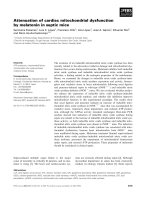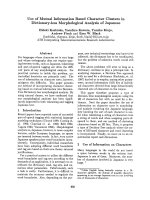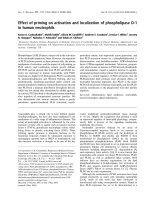Báo cáo khoa hoc:" Fusion of green fluorescent protein to the C-terminus of granulysin alters its intracellular localization in comparison to the native molecule" pptx
Bạn đang xem bản rút gọn của tài liệu. Xem và tải ngay bản đầy đủ của tài liệu tại đây (382.95 KB, 3 trang )
BioMed Central
Page 1 of 3
(page number not for citation purposes)
Journal of Negative Results in
BioMedicine
Open Access
Brief report
Fusion of green fluorescent protein to the C-terminus of granulysin
alters its intracellular localization in comparison to the native
molecule
Dennis A Hanson*
1
and Steven F Ziegler
2
Address:
1
Department of Orthopaedics and Sports Medicine, University of Washington, Seattle, WA 98195 USA and
2
Benaroya Research Institute
at Virginia Mason, Seattle, WA 98101 USA
Email: Dennis A Hanson* - ; Steven F Ziegler -
* Corresponding author
Abstract
The engineering of green fluorescent protein (GFP) fusion constructs in order to visibly tag a
protein of interest has become a commonly used cell biology technique. Although caveats to this
approach are obvious, literature reports in which the chimeric molecule behaves differently than
the native molecule are scant. This brief report describes one such case. Granulysin, a small lytic
and antimicrobial protein produced by cytotoxic lymphocytes, traffics to the regulated secretory
system and is subsequently released from cells upon proper stimulus. In an attempt to elucidate
mechanisms by which it accumulates in and is released from cytolytic granules, GFP was fused to
the C-terminus of granulysin and expressed in an NK cell line. A control construct expressing the
native protein was similarly expressed. The data demonstrate that, while the fusion protein is
expressed and secreted, its subcellular localization is altered in comparison to native granulysin.
Thus, the addition of GFP to the C-terminus of granulysin obscures the signal(s) that cytotoxic
lymphocytes use to sort it to the regulated secretory pathway despite its normal biosynthesis and
secretion. This example is offered as a cautionary account for other researchers who contemplate
using this technology.
Background
The intrinsically fluorescent protein from the jellyfish
Aequoria victoria, termed green fluorescent protein (GFP),
can be used to visualize dynamic processes in live cells in
real time [1]. A fusion between a molecule of interest and
GFP is supposed to localize fluorescence to the normal
intracellular locale of the target protein. This technology
has been used to study the intracellular location and
dynamics of many different proteins in many different
organisms. Included in this group are proteins that traffic
to and ultimately are released from regulated secretory
compartments [2]. In this report an attempt was made to
use a GFP fusion protein strategy to study the regulated
secretory compartment of cytotoxic lymphocytes.
Vertebrate organisms have developed a system of contact-
dependent cytotoxicity in order to control tumors and
infection. Specialized cytotoxic lymphocytes, T cells and
natural killer (NK) cells, function as effector cells in this
system [3]. Cell surface receptors on these cells recognize
changes to cell surface molecules of transformed or
infected cells. Signaling through these receptors initiates
target cell destruction. A major method used by these cells
to kill targets is the regulated exocytosis of cytolytic
Published: 10 September 2004
Journal of Negative Results in BioMedicine 2004, 3:2 doi:10.1186/1477-5751-3-2
Received: 20 November 2003
Accepted: 10 September 2004
This article is available from: />© 2004 Hanson and Ziegler; licensee BioMed Central Ltd.
This is an open-access article distributed under the terms of the Creative Commons Attribution License ( />),
which permits unrestricted use, distribution, and reproduction in any medium, provided the original work is properly cited.
Journal of Negative Results in BioMedicine 2004, 3:2 />Page 2 of 3
(page number not for citation purposes)
granules [4]. The active components of these organelles
and mechanisms by which they lead to target cell death
have been well studied. However, the underlying molecu-
lar mechanisms governing their biogenesis and release
remain less well understood. Adaptation of GFP tagging
technology to analyze these processes might therefore be
of considerable value in elucidating the underlying molec-
ular mechanisms. Thus, GFP was fused to granulysin, a
small secreted protein that sorts to and accumulates in
cytolytic granules [5,6], and expressed in the functional
human NK cell line YT [7]. The YT cell line was utilized in
this study because it had previously been stably trans-
fected with native granulysin and shown to properly pro-
duce and accumulate the processed product in its
regulated secretory compartment [6].
Findings
Stable transfectant lines for native granulysin, GFP-tagged
granulysin, and non-fused GFP were derived using G418
selection. The GFP proteins were first characterized by
immunoblot analysis of lysates and cell supernatants
probed with antisera to GFP (figure 1a). The cell line
transfected with the granulysin-GFP expression construct
produces a doublet of proteins in the correct molecular
weight range for the fusion protein, with both the cell
lysate and supernatant media containing immunoreactiv-
ity. No explanation presently exists as to the difference
between the two proteins of the doublet. The cell line
expressing non-fused GFP, which does not contain a sig-
nal sequence, displayed an immunoreactive protein only
in the cell lysate and not in the extracellular media. Thus,
the granulysin-GFP fusion construct correctly directs the
biosynthesis of the chimeric molecule into the secretory
pathway. A previous publication demonstrated that a
native granulysin transfectant also expresses protein,
detectable by anti-granulysin sera, in both lysate and
extracellular media fractions [6]. Next, the intracellular
localization of native granulysin and granulysin-GFP was
analyzed by two color immunofluorescent confocal
microscopy using a polyclonal antisera reactive to granu-
lysin and a monoclonal antibody reactive to perforin, a
well characterized constituent of cytolytic granules [4]
(figure 1b). Significant overlap in the dual staining, as evi-
denced by the abundant yellow signal, demonstrates that
transfected native granulysin co-localizes with perforin in
granules. On the contrary, the granulysin-GFP fusion pro-
tein displays very little overlap in staining with perforin,
indicating that the chimera is altered in its subcellular dis-
tribution in comparison to the native molecule. Conclu-
sions to be drawn from these data regarding the
mechanism(s) of sorting to cytolytic granules are limited
but could suggest that altering the overall biophysical
properties of granulysin by the addition of the relatively
large GFP moiety negates the information necessary to
gain entrance into the correct secretory pathway. How-
ever, of perhaps broader scientific significance, the data
serve as a striking demonstration of an obvious but sel-
dom published limitation of using GFP fusion proteins as
substitutes for the native molecules.
Granulysin-GFP fusion protein is expressed and secreted but doesn't colocalize with perforinFigure 1
Granulysin-GFP fusion protein is expressed and
secreted but doesn't colocalize with perforin. a)
Immunoblot analysis using anti-GFP sera was performed on
cell lysate and cell media supernatant samples of YT cells
expressing granulysin-GFP fusion protein (YT.granGFP) and
native GFP (YT.GFP). b) Confocal immunofluorescence stain-
ing for granulysin (green) and perforin (red) was performed
for YT expressing native granulysin (YT.granulysin) and gran-
ulysin-GFP fusion protein (YT.granGFP).
Publish with BioMed Central and every
scientist can read your work free of charge
"BioMed Central will be the most significant development for
disseminating the results of biomedical research in our lifetime."
Sir Paul Nurse, Cancer Research UK
Your research papers will be:
available free of charge to the entire biomedical community
peer reviewed and published immediately upon acceptance
cited in PubMed and archived on PubMed Central
yours — you keep the copyright
Submit your manuscript here:
/>BioMedcentral
Journal of Negative Results in BioMedicine 2004, 3:2 />Page 3 of 3
(page number not for citation purposes)
Materials and Methods
Cells
The NK cell line YT was transfected via electroporation
with the linearized expression construct plasmids of full-
length native granulysin-pcDNA3.1, full-length granu-
lysin (res. 1-145)-pGFP and control non-fused pGFP. Sta-
ble transfectants were selected and grown in RPMI 1640 +
10% fetal bovine serum containing 1 mg/ml G418.
Immunoblots
One ml liquid aliquots of log-phase cells were pelleted
(supernatant saved), washed in PBS, and lysed in 100 µl
of reducing sample buffer. The supernatant was diluted
1:1 (v:v) in 2X sample buffer containing DTT. Ten µl of
lysate sample (10% of total) and 10 µl of supernatant
sample (0.5% of total) were loaded into wells of a 10%
PAGE-SDS gel. After electrophoretic separation, proteins
in the gel were transferred to nitrocellulose using a semi-
dry blot apparatus. Blots were probed with rabbit antisera
specific for GFP followed by peroxidase-conjugated anti-
rabbit antibodies. Reactive protein bands were revealed by
chemiluminescent detection.
Confocal microscopy
Log-phase cells were immobilized in wells of a poly-L-
lysine coated printed glass slide. After fixation with 4%
(w/v) paraformaldehyde in PBS, the cells were permeabi-
lized for 30 minutes in staining buffer [10% (v/v) normal
goat serum, 1% (w/v) nonfat dry milk powder, 0.1% (w/
v) saponin, in PBS]. Next, samples were incubated for 30
minutes with primary antibodies to granulysin (rabbit
antisera) and perforin (mouse mAb) diluted in staining
buffer. After washing 3X with staining buffer, samples
were incubated 30 minutes with species-specific fluores-
cent Alexa 488 goat anti-rabbit and Alexa 568 goat anti-
mouse secondary antibodies (Molecular Probes). Cells
were then washed 3X with staining buffer, then twice with
PBS, and glass coverslips mounted using 50% (v/v) glyc-
erol in PBS. Images were collected using a BioRad MRC
1024 confocal imaging system mounted on a Nikon Dia-
phot inverted microscope.
Authors' contributions
DAH designed the study, carried out all experimental pro-
cedures, and drafted the manuscript. SFZ consulted on the
experimental design, provided the resources that allowed
the study to be conducted and edited the manuscript.
Both authors read and approved the final manuscript.
References
1. Patterson GH, Knobel SM, Sharif WD, Kain SR, Piston DW: Use of
the green fluorescent protein and its mutants in quantitative
fluorescence microscopy. Biophys J 1997, 73:2782-2790.
2. Kaether C, Salm T, Glombik M, Almers W, Gerdes HH: Targeting
of green fluorescent protein to neuroendocrine secretory
granules: a new tool for real time studies of regulated pro-
tein secretion. Eur J Cell Biol 1997, 74:133-142.
3. Russell JH, Ley TJ: Lymphocyte-mediated Cytotoxicity. Ann Rev
Immunol 2002, 20:323-370.
4. Page LJ, Darmon AJ, Uellner R, Griffiths GM: L is for lytic granules:
lysosomes that kill. Biochim Biophys Acta 1998, 1401:146-156.
5. Pena SV, Hanson DA, Carr BA, Goralski TJ, Krensky AM: Process-
ing, subcellular localization, and function of 519 (granulysin),
a human late T cell activation molecule with homology to
small, lytic, granule proteins. J Immunol 1997, 158:2680-2688.
6. Hanson DA, Kaspar AA, Poulain FR, Krensky AM: Biosynthesis of
granulysin, a novel cytolytic molecule. Mol Immunol 1999,
36:413-422.
7. Yodoi J, Teshigawara K, Nikaido T, Fukui K, Noma T, Honjo T, Taki-
gawa M, Sasaki M, Minato N, Tsudo M: TCGF (IL 2)-receptor
inducing factor(s). I. Regulation of IL 2 receptor on a natural
killer-like cell line (YT cells). J Immunol 1985, 134:1623-1630.









